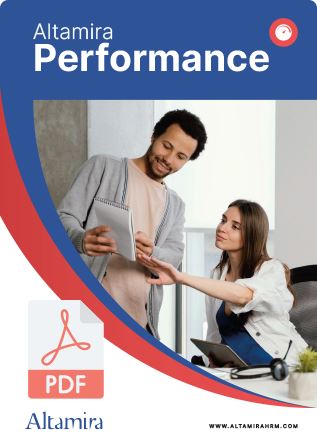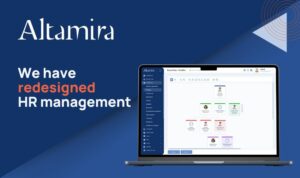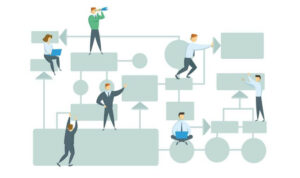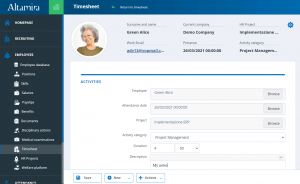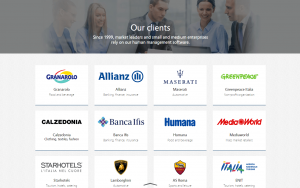Introducing a performance evaluation system in your company is one of the most useful projects an HR department can devote itself to, especially now that one has to monitor and motivate a workforce that is spread across a wide territory.
However, there is no one-size-fits-all solution.
An employee evaluation system must be tailored to the needs and characteristics of the individual firm.
First, one needs to identify specific goals for the project. One needs to determine whether one wants to achieve increased productivity, motivate employees, set up an incentive system, organize career paths, reduce turnover, or something else.
The evaluation system should then be customized to take into account many other elements, such as the sector of the firm, the functions to be assessed, the organization of activities, the prevalence of remote working, etc.
What are the defining elements of an evaluation system?
In so many years of digitizing performance management systems, we have yet to find two companies that had the same employee evaluation model.
This is because there are many elements to consider and choices to make:
1) Frequency
One of the first decisions to make in building a performance evaluation system concerns the frequency of the evaluation.
The choice is vast, and can range from annual, semi-annual or monthly evaluations to daily or impromptu feedback, with all the shades in between.
More frequent evaluations allow for earlier identification of problems and necessary course changes, but they make the system more burdensome for everyone involved and make it difficult to get an overall picture of the situation.
2) Actors
Who are the evaluators and who are those being evaluated?
Typically, a worker may be evaluated by:
- Their direct manager
- Themselves
- One of their co-workers at the same level
- One of their direct reports
- HR management
- A customer
The most common evaluation is that of the direct manager. This is because the manager has all the information they need to correctly assess a direct report, but there is always the risk of favoritism and bias caused by the personal relationship. This is why it is essential that managers be appropriately trained.
Self-evaluation is a useful exercise in personal growth, but it has obvious limitations. Many people tend to underestimate their own merits, while others exaggerate them.
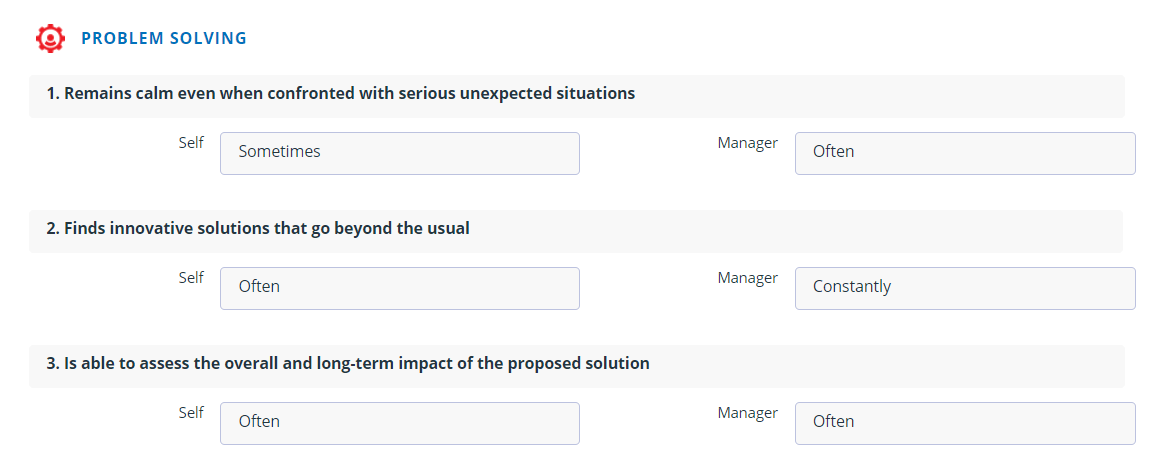
In some systems, multiple evaluations coexist. In this case the manager evaluates an employee, who in turn evaluates himself. An example taken from Altamira Performance.
A colleague’s evaluation may be more on point than a manager’s in certain contexts, or offer an additional perspective, but the risk of conflict of interest and bias is even higher, especially when evaluations are tied to promotions or bonuses.
Customer evaluations work well for certain roles, for example in the customer care department, but obtaining feedback can be complicated and expensive.
HR management is able to make an objective assessment, but can only comment on a few elements, as they often do not have direct and constant contact with the one being evaluated.
Finally, evaluations from direct reports can get a manager to grow, but this is unreliable. If done anonymously, it can drive employees to “retaliate” against a strict boss; if transparent, it can drive them to inflate the scores to ingratiate themselves with him/her.
Thus, those evaluating and those being evaluated change from system to system. These range from self-evaluation only, to manager-subordinate evaluation, to peer review, all the way to very complex scenarios such as 360.
3) The object of evaluation
But what should employees be evaluated on?
The most common items of evaluation are:
- skills
- performance
- objectives
- behaviors
- potential
- personality traits
Again, the choice must be made with the ultimate purpose of the evaluation process in mind.
If we are targeting increased employee productivity, the choice might fall on quantitative goals. If the focus is on human resource development, we might consider evaluating soft skills, hard skills or a mixture of both, depending on the importance given to them in the firm.
4) KPIs
In order to monitor the outcome of assessments, whether at the individual, team and/or company level, it is appropriate to establish KPIs that are consistent with the subject of the assessment.
If you are assessing the skills of your staff, it will be useful to look at the skills gap between the required and actual level, while in an MBO system you will need to look at the percentage of achievement of objectives.
By tracking KPIs, we will be able to create reports and statistics to understand the performance of employees and of our evaluation process.
5) Follow-up/Development Actions
An evaluation process should not remain an end in itself but should always involve the professional growth of the company staff.
Aside from the association with bonuses and rewards, it is always a good idea to provide for development actions at the end of the cycle. For example, attending a course to close the gap found in a skill or objective.
Performance evaluation: comparing systems
Used in some form since ancient times, performance evaluation systems have begun to be used in companies in a structured manner since the last century.
Since then, there have been a vast number of different models, each with more or less obvious merits and flaws.
In recent years, the systems used mainly belong to 3 categories.
Let’s look at them in detail.
Annual Review
This evaluation model involves an annual evaluation and is probably the most widely used in the world.
This is a top/down assessment, in which the manager of a team evaluates one of its members.
It may also include one or more reviews during the year, as well as the presence of a self-evaluation by the employee.
Previously paper-based, the annual review has now become more interactive, efficient and smart-working-friendly with cloud-based software such as Altamira Performance.
The object of the evaluation varies from model to model. Some of the most common are:
- assessment of personal, team and/or company goals
- assessment of hard skills
- assessment of soft skills
- assessment of soft skills through observable behaviors
- a mixture of the above
The annual review concludes with a final evaluation, which is easy to link to a reward system, actions for development or reflections on career plans.
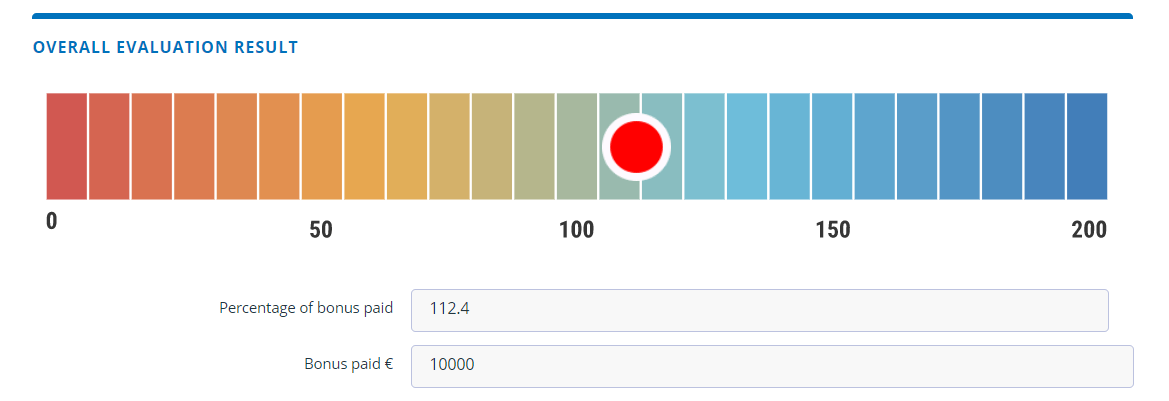
An example of a bonus associated with the final evaluation of an MBO system. Taken from Altamira Performance.
The merits of the annual review
- Easy to associate with a Management by Objectives (MBO) and reward system
- Requires little effort from the actors in the process
- Gives a single, clear and detailed result
- Easy to associate with actions for development
- Suitable for companies of all sizes
The shortcomings of the annual review
- Does not intervene promptly to resolve critical issues
- If interim reviews are not performed, the evaluation is likely to refer mainly to the final period of the year
- If interim reviews are not performed, the objectives and/or skills to be assessed may become less relevant over the course of the year.
- Low level of engagement
Continuous Feedback
Continuous feedback is the staff evaluation system that has been most talked about in recent years.
As the name implies, it requires timely and frequent feedback for the worker—from a simple like to an evaluation on a scale of 1 to 10. It was born from the need to increase the exchange of views between managers and employees and the engagement of employees.
This system can also be set up in an endless number of ways, varying according to the subjects involved, the frequency of the feedback, the object of the evaluation, etc.
It is most often based on evaluating observable behaviors: the evaluator observes a colleague’s behavior (for example, during a meeting or in solving a problem) and quickly provides feedback.
The large amount of feedback given means that this evaluation system needs to be digitized, with a widespread preference for mobile apps that can better accommodate the impromptu nature of evaluations.
The spread of continuous feedback has been slowed by the growth of smart working, which makes direct observation of colleagues’ behavior difficult.
The merits of continuous feedback
- Informal and timely assessments that reinforce positive behaviors
- Allows for continuous course correction
- High level of engagement
The shortcomings of continuous feedback
- High technological implementation costs
- Only for large companies
- It doesn’t give a final result, so it’s not very suitable for supporting MBOs and development actions
- Very invasive for actors, with high risk of abandonment
- Not suitable for smart working
360
The 360 system is a performance evaluation system in which the worker receives feedback from every direction: from peers, direct reports, and even customers.
It is mainly used to evaluate managers and analyzes the influence they have on the work of their team in terms of leadership, management, teamwork, etc.
The feedback received, whether in numeric or text format, is typically managed by a computer system and presented to the manager in the form of a report.
The more detailed the evaluations, the more insights the manager will have to get better in their work.
The merits of 360
- Gives a comprehensive view of a manager’s reputation in the company
- Increases staff engagement and empowerment
- Helps managers grow professionally
The shortcomings of 360
- High technology and consulting costs for implementation
- Only for large companies
- Requires some effort from the actors in the process
- High risk of bias in evaluations
- Not all managers are able to accept feedback with equanimity
Evaluating a performance evaluation system
In order to assess the effectiveness of an evaluation system, it is necessary to be clear from the outset as to what goals you want to achieve with its introduction.
If your main goal is to increase staff motivation and engagement, you can analyze the results with an employee survey.
In the case of quantitative goals—for example, decreasing the turnover rate or increasing productivity—you will need to monitor and compare these KPIs instead.
One of the most common mistakes companies make is not conducting a performance management system satisfaction survey.
Finally, some assessment systems can co-exist. Some firms use continuous feedback systems to maintain high staff engagement and an annual review to assess the achievement of goals and award bonuses and rewards.
Copyright: ©TarikVision/Adobe Stock




